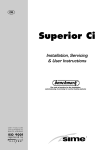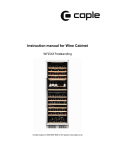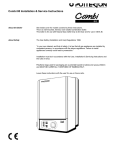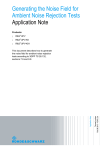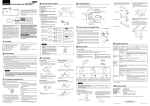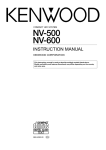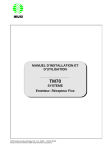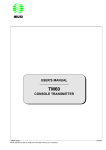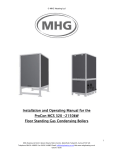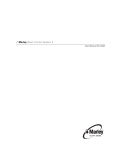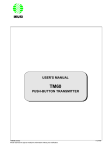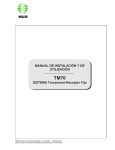Download Bock Water heaters 40E Technical data
Transcript
30e, 40e, 50e, 60e, & 80e, fanned balanced flue gas fired boilers THIS APPLIANCE IS FOR USE WITH NATURAL GAS (G20) ONLY Installation and Servicing Instructions LEAVE THESE INSTRUCTIONS ADJACENT TO THE GAS METER. GAD (90/396/EEC) POTTERTON PROFILE 30e G.C. No. 41 .605.39 POTTERTON PROFILE 40e G.C. No. 41 .605.40 POTTERTON PROFILE 50e G.C. No. 41 .605.41 POTTERTON PROFILE 60e G.C. No. 41 .605.42 POTTERTON PROFILE 80e G.C. No. 41 .605.43 IMPORTANT This appliance must be installed and serviced by a competent person as stated in the Gas Safety (Installation and Use) Regulations 1994. Profile boilers are certified for safety, it is therefore important that no external control devices (e.g. flue dampers, economisers, etc.) be directly connected to these appliances unless covered by these installation instructions or otherwise recommended in writing. Any direct connection of a control device not approved by Potterton could invalidate the certificate and the normal warranty. LIST OF CONTENTS - Page 2 General Optional Extras Accessories Installation Data Boiler Dimensions Page No. 2 Page No. 2 Page No. 3 Page No. 3 Page No. 3 Site Requirements Technical Data Installation Instructions Commissioning Health and Safety Information Control Systems, Pipework and Wiring Guide User’s Instructions Page No. 3 Page No. 6 Page No. 11 Page No. 18 Back Page Supplied in Literature Pack GENERAL - Page 2 Potterton Profile boilers are fully automatically controlled wall mounted fan powered balanced flue appliances, using a cast iron heat exchanger and are available in five outputs ranging from 5.86-23.44kW (20,000-80,000 Btu/h). The boilers which are designed to provide domestic hot water and/or central heating must be used on INDIRECT hot water systems only. The cast iron heat exchangers are suitable for use on open vented gravity domestic hot water/pumped central heating systems or fully pumped systems which may be sealed or open vented. All boilers can be supplied with either of the following types of flue system: 1) Standard horizontal flue system suitable for wall thickness of 100mm (4 in.) to 510mm (20 in.). 2) 2 metre horizontal flue system which provides a maximum flue length Of 1955mm (77 in.). 3) Vertical flue system which allows the flue to pass through a flat roof and terminate at a maximum height of 1980mm (78 in.) measured from the top of the boiler case. OPTIONAL EXTRAS - Page 2 The following are kits available as optional extras:— Internal Fitment Kit, which is suitable for a maximum wall thickness of 51 0mm (20 in.) is to be used where access to the outside wall is impracticable. Pump Cover Kits, located on top of the boiler and designed to conceal the pump, and/or any motorised valves installed above the boiler. (Note: Pump cannot be fitted above the boiler if the vertical flue kit is used). Terminal Wall Plate, where necessary can be fitted to the outside wall face to improve the appearance, after making good around the terminal. Terminal Guard, to be used when the terminal is fitted less than 2m above a balcony, above ground or above a flat roof to which people have access. Full fitting instructions are provided with each kit. P.I.L. PART Nos. ACCESSORIES - Page 3 The following Potterton Myson controls are recommended for use with your boiler:Electronic Programmer EP2001, EP3001, or EP6000 Cylinder Thermostat PTT2 or PTT1 00 Room Thermostat PRT2 or PRT1 00 Frost Thermostat PRT1 00 FR Motorised Zone Valve M5V222 or M5V228 Motorised Diverter Valve M5V322 Thermostatic Radiator Valve Data sheets describing these products are available on request. INSTALLATION DATA - Page 3 The installation of the boiler must be in accordance with the latest relevant requirements of the Gas Safety (Installation and Use) Regulations, local building regulations, lEE Wiring Regulations and the Byelaws of the Local Water Undertaking. Detailed recommendations are contained in the following British Standards and Codes of Practice. B55440 Part 2 B55449 Part 1 B55546 B5481 4. B56891. BUILDING REGULATIONS. MODEL WATER BYELAWS. BRITISH GAS PUBLICATION DM2. GAS SAFETY (INSTALLATION AND USE) REGULATIONS. BUILDING STANDARDS (SCOTLAND) REGULATIONS. BS6798, B55440 Part 1 BOILER DIMENSIONS - Page 3 R.c ½ *NOTE: IF PIPEWORK IS TO BE RUN DOWN THE BACK OF THE BOILER THE NORMAL CLEARANCE OF 25mm BETWEEN THE REAR OF THE BOILER AND WALL CAN BE INCREASED TO 35mm IF DESIRED BY INVERTING THE BOILER MOUNTING PLATE DURING INSTALLATION (Dimensions in brackets apply when the mounting plate is inverted). SITE REQUIREMENTS - Page 3 These boilers are not suitable for external installation and should not be fitted directly above a cooking appliance. The boiler may be installed in any room, although particular attention is drawn to the requirements of the current I.E.E. Wiring Regulations and in Scotland, the electrical provisions of the Building Standards applicable in Scotland with respect to the installation of the appliance in a room containing a bath or shower. Where a room-sealed appliance is installed in a room containing a bath or shower, any electrical switch or appliance control, utilising mains electricity should be so situated that it cannot be touched by a person using the bath or shower. SITE REQUIREMENTS - Page 4 FIG. 2 GENERAL ARRANGEMENT SITE REQUIREMENTS - Page 5 Where the installation of the boiler will be in an unusual location, special procedures may be necessary and BS 6798 gives detailed guidance on this aspect. 50mm (2 in) at the top (measured from the top of the boiler case), except where the optional extra pump cover is to be fitted, when 178mm (7 in) should be allowed. Ensure that the gas supply pipe and meter are large enough for this appliance and any others that may be run off the same meter. Reference should be made to B56891 100mm (4 in) at the bottom of the boiler. Boiler Mounting Surface The boiler must be mounted on a flat wall, which may be of combustible material and must be sufficiently robust to take the weight of the boiler. The requirements of the local authorities and the Building Regulations must be adhered to. IMPORTANT NOTICE: TIMBER FRAMED HOUSES Additional clearances to these are required during installation for lifting the boiler and 127mm (5 in) is required at the top of the boiler for access to the pipe connections. Ventilation If the boiler is to be installed in a confined space such as a cupboard, the space will need ventilating. Openings must be provided at the top and bottom of the Cupboard each of which should have a free area as shown in TABLE 1. Further details for installation of a boiler within a compartment are given in BS 6798. If the appliance is to be fitted in a timber framed building, it should be fitted in accordance with British Gas Publication ‘Operational Procedures for Customer Service’ Part 19. If in any doubt, advice should be sought from the local region of British Gas. TABLE 1 AIR VENT AREAS PROFILE 30e 40e 50e 60e 80e Clearances Around the Boiler The following minimum clearances must be maintained after installation, for correct operation and servicing of the boiler: in2 16 21 26 32 43 cm2 103 135 170 206 277 610mm (2 ft) at the front of the boiler 5mm (0.2 in) each side of the boiler If the openings draw air from outside the building the free areas may be halved. Refer to BS 5440 Part 2 for further guidance. Balanced Flue Terminal and Ducting The fresh air inlet and flue ducts can be run from either the left, right, rear or top of the boiler to a miniature terminal on the outside of the building. INFORMATION RELATING TO VERTICAL FLUING IS PROVIDED IN THE PACK CONTAINING THE VERTI-CAL FLUE SYSTEM. The minimum spacings from the terminal to obstructions and ventilation openings are shown in FIG. 3. For information appertaining to horizontal flue lengths reference should be made to FIG. 4. NOTE Where a flue terminal is fitted less than 1000mm from a plastic or painted gutter or 500mm from painted eaves, an aluminium shield of 1000mm length should be fitted to underside of gutter or eaves. If a terminal is fitted less than 2m above a balcony, above ground or above a flat roof to which people have access then a suitable terminal guard should be fitted. (P.l.L. No. 205792). Any car port or other add-on extension should consist of a roof or a roof and one other wall. If it consists of a roof and two other walls − the installation shall be treated as suspect and further advice sought. Refer to B55440 Part 1 for further guidance. POSITION A. B. C. D. E. F. G. H. I. J. K. FIG. 3 THE SITING OF BALANCED FLUE TERMINALS L. M. MINIMUM DISTANCE mm DIRECTLY BELOW AN OPENABLE WINDOW, AIR VENT, OR ANY OTHER VENTILATION OPENING. BELOW GUTTER, DRAIN/SOIL PIPE BELOW EAVES BELOW A BALCOY OR CAR PORT ROOF FROM VERTICAL DRAIN PIPES AND SOIL PIPES FROM INTERNAL OR EXTERNAL CORNERS ABOVE ADJACENT GROUND OR BALCONY LEVEL FROM A SURFACE FACING THE TERMINAL FACING TERMINALS FROM OPENING (DOOR/WINDOW) IN CARPORT INTO DWELLING VETICALLY FROM A TERMINAL ON THE SAME WALL HORIZONTALLY FROM A TERMINAL ON THE SAME WALL ADJACENT TO OPENING 300 25 25 25 75 25 300 600 1,200 1,200 1,500 300 150 SITE REQUIREMENTS - Page 6 ALL MODELS REAR OR SIDE FLUEING MAXIMUM LENGTH ‘X’ STANDARD FLUE SYSTEM 510mm (20in) 1 METRE FLUE SYSTEM 955mm (37in) FIG. 4 FLUE LENGTHS ELECTRICITY SUPPLY A 240 volts -~ 50Hz, single phase electricity supply fused to 3 amperes, must be provided in accordance with the latest edition of the I.E.E. Wiring Regulations and any other local regulations that may apply. The current rating of the wiring to the boiler must exceed 3 amperes and have a cross sectional area of at least 0.75mm2 in accordance with B56500 Table 16. The supply to the boiler and its associated equipment should be controlled by an exclusive 3A fused double pole switch (having at least 3mm contact separation in both poles) so that complete isolation from the supply can be achieved to enable servicing work to be carried out in safety. TECHNICAL DATA Maximum working head Minimum working head on Fully Pumped systems Minimum circulating head on Gravity systems Gas supply pressure Maximum Flow temperature Electricity supply Power consumption Flow/Return connection 30.5m (100 ft) Gas supply connection Rc. 1/2 (i/2in BSP Female) Water Content Models 30e, 40e 6.0 litre (1.32 gal) Models 50e, 60e & 80e 6.5 litre (1.43 gal) Appliance Weight-installed Appliance Weight-lift Models 30e, 40e 52kg (115 Ibs) 46kg (101 Ibs) Appliance Weight-installed Appliance Weight-lift Models 50e, 60e & 80e 62kg (137 Ibs) 53kg (117 Ibs) 305mm (1 ft) 1.2m (4ft) 20mbar 820C 240v~-50Hz fused at 3A 80 watts (excluding pump) 22mm copper on 30e, 40e models 28mm copper on 50e, 60e, 80e models SITE REQUIREMENTS - Page 7 BOILER SIZE Min INJECTOR SIZE GAS RATE m3/h (ft3/h) INPUT kW(Btu/h) OUTPUT kW(Btu/h) BURNER PRESSURE mbar in wg 2.9mm 0.73(25.8) 0.9(31.95) 1.05(36.92) 7.83(26702) 9.69(33068) 11.20(38217) 5.86(20000) 7.33(25000) 8.79(30000) 5.9 7.8 10.4 2.4 3.1 4.2 3.1mm 1.09(38.34) 1.24(43.8) 1.39(49.23) 11.63(39682) 13.29(45336) 14.93(50955) 8.79(30000) 10.26(35000) 11.72(40000) 8.4 10.8 13.4 3.4 4.3 5.4 3.5mm 1.39(50.23) 1.58(55.74) 1.75(61.84) 15.24(52000) 16.90(57692) 18.76(64000) 11.72(40000) 13.19(45000) 14.65(50000) 8.7 11.0 12.8 3.5 4.4 5.1 3.8mm 1.79(63.09) 1.94(68.55) 2.11(74.4) 19.14(65300) 20.79(70950) 22.57(77000) 14.65(50000) 16.12(55000) 17.58(60000) 10.3 12.0 14.0 4.1 4.8 5.6 4.4mm 2.18(77.1) 2.5 (88.4) 2.82(99.71) 23.39(79800) 26.82(91503) 30.25(103200) 17.58(60000) 20.52(70000) 23.45(80000) 8.5 11.0 14.0 3.4 4.4 5.6 30e Max Min 40e Max Min 50e Max Min 60e Max Min 80e Max CIRCULATION PUMP SELECTION The resistance through the heat exchanger when operating with a water flow rate producing an 11 0C temperature rise at maximum boiler output are shown in TABLE 2. If other controls, such as three-position valves are used in the system, the resistance through them, quoted in their manufacturer’s literature must be taken into account. The pump may be fitted on either the flow or return and MUST be wired directly to the boiler terminal block, see FIG. 24. It must be fitted with two isolating valves which are positioned as close to the pump as possible. Closing of any valve must always leave the open vent unobstructed. FIG. 5 PRESSURE LOSS ACROSS BOILER TABLE 2 SITE REQUIREMENTS - Page 8 The System The boiler must be used on INDIRECT hot water systems only. It is suitable for use on open vented gravity domestic hot water/pumped central heating systems or, fully pumped systems which may be sealed or open vented. necessary. The total length of the by-pass circuit taken from the boiler connections should be greater than 4 metres of 22 mm pipe. It should be fitted with a lockshield valve and be adjusted to maintain a minimum flow through the boiler of 4.5 litres/mm (1 gal/mm) see FIGS 6, 7. The system should be designed so that the maximum static head does not exceed 30.5 m (100 ft) and a minimum on fully pumped systems of 305 mm (1 ft). See FIG. 6. Systems fitted with controls which allow the boiler to operate when both the hot water and central heating circuits are closed i.e. mechanically operated thermostatic control valves, must be fitted with a by-pass circuit capable of:— Gravity domestic hot water circuits should have a minimum circulating head of 1.2 m (4ft). See FIG. 8. 1. 2. To ensure optimum boiler performance on both gravity hot water and fully pumped systems a change-over switch is incorporated in the boiler control box. The boiler is supplied with the switch set for sealed or open vented fully pumped systems. A suggested method of meeting these requirements by using a bathroom radiator fitted with two lockshield valves is shown in FIGS. 6, 7. Dissipating a minimum of 1 kW (3400 Btu/h) Maintaining a minimum water flow through the boiler of 9 litres/mm (2 gal/mm). If the boiler is to be used on a system with gravity hot water the switch should be set at the GRAVITY position. In addition the bulb of the overheat thermostat should be repositioned as shown in FIG. 21. Additional system information can be found in the Control Systems, Pipework and Wiring Guide. To prevent reverse circulation in the gravity circuit when the pump is running an injector disc is provided to form an injector tee at the return connection on the boiler. See FIG. 20. Installation On all systems the pump should be wired to the boiler terminal block. To prevent nuisance operation of the overheat thermostat, it is important that where electrically operated zone valves are used the boiler is wired so it does not cycle when the zone valves are closed. Also, systems fitted with controls that close both hot water and central heating circuits while the boiler is still hot, must be fitted with a by-pass circuit to dissipate the residual heat within the boiler. Further information on by-pass arrangements is provided in later notes and illustrations. Drain off taps should be fitted in the pipework close to the boiler and in the low points of the system. SEALED SYSTEMS (FULLY PUMPED) The installation must comply with the requirements of BS 6798 and BS 5449 Part 1. The B.G. publication “British Gas Specification for Domestic Wet Central Heating Systems” should also be consulted. Safety Valve A non adjustable spring-loaded safety valve, preset to operate at 3 bar (451bf/in2) shall be used. It must comply with BS 6759 Part 1 and include a manual testing device. It shall be positioned in the flow pipe either horizontally or vertically upwards and close to the boiler. No shut-off valves are to be placed between the boiler and the safety valve. The valve should be installed into a discharge pipe which permits the safe discharge of steam and hot water such that no hazard to persons or damage to electrical components is caused. Pressure Gauge Note: Although the system can be emptied using the drain off taps installed in the pipework around the system, to empty the boiler it is necessary to remove the drain off cap positioned within the boiler case. See FIG. 2. Combined Gravity Hot Water Pumped Central Heating Systems. Where a cylinder thermostat and zone valve is used to control the temperature of the hot water it is recommended that a by-pass be installed in the gravity circuit. A suggested method of doing this is shown in FIG. 8 where the bathroom radiator is connected into the gravity circuit and is fitted with two lockshield valves. Mechanically operated thermostatic domestic hot water temperature control valves which allow the boiler to operate when the valve is closed or partially closed MUST NOT BE FITTED. Fully pumped Systems With the change-over switch in the control box set at the FULLY PUMPED position, the pump will be controlled by an over-run thermostat. This will ensure that the pump will continue to run after boiler shut down if the water temperature in the boiler is high, thus preventing nuisance operation of the overheat thermostat. If a three port diverter valve is used as shown in FIGS. 6, 7 a bypass is not necessary since one circuit is always open. A pressure gauge incorporating a fill pressure indicator, covering the range 0-4 bar (60 lbf/in2) shall be fitted to the system. It should be connected to the system, preferably at the same point as the expansion vessel. Its location should be visible from the filling point. Expansion Vessel A diaphragm type expansion vessel to B54814 Part 1 shall be fitted close to the inlet side of the pump. The connecting pipework should not be less than 15 mm (½ in nominal). Pipework connecting the expansion vessel should not incorporate valves of any sort. Methods of supporting the vessel are supplied by the manufacturer. The nitrogen or air charge pressure of the expansion vessel shall not be less than the hydrostatic head, (height of the top point of the system above the expansion vessel). To size the expansion vessel it is first necessary to calculate the volume of water in the system in litres. The following volumes may be used as a conservative guide to calculating the system volume. Boiler Heat Exchanger: Small Bore Pipework: Micro Bore Pipework: Steel Panel Radiators: Where a pair of two port valves are used, a by-pass is Low Water Capacity Radiators: Hot water Cylinder: 6.5 litres 1 litre per kW of system output 7 litres 8 litres per kW of system output 2 litres per kW of system output 2 litres SITE REQUIREMENTS - Page 9 Vessel Charge Pressure(bar) 0.5 1.0 Method of Make-Up Provision shall be made for replacing water loss from the system either:— i) from a make-up vessel or tank mounted in a position higher than the top point of the system, and connected through a non-return valve to the system on the return side of hot water cylinder or the return side of all heat emitters. or ii) where access to a make-up vessel would be difficult by using the mains top up method or a remote automatic pressurisation and make-up unit as illustrated in FIG. 7 METHODS 1 and 2. Initial System Pressure (bar) 1.0 1.0 Mains Connection If the system is extended, the expansion vessel volume may have to be increased unless previous provision has been made for the extension. Where a vessel of the calculated size is not available, the next available larger size should be used. The boiler flow temperature is controlled at approximately 820C. The vessel size can now be determined from the following table where V=System volume in litres. Expansion Vessel Volume (litres) V x 0.11 V x 0.087 Cylinder The hot water cylinder must be an indirect coil type or a direct cylinder fitted with an immersion calorifier suitable for operating at a gauge pressure of 0.3 bar (51 bf/in2) in excess of safety valve setting. Single feed indirect cylinders are not suitable for sealed systems. FIG. 6 OPEN VENTED FULLY PUMPED SYSTEM FITTED WITH A COMBINED FEED AND VENT There shall be no connection to the mains water supply or to the water storage tank which supplies domestic water even through a non-return valve, without the approval of the local Water Authority. Filling Point The system shall be fitted with a filling point at low level which incorporates a stop valve to BS1 010 and a double check valve (approved by the National Water Council) to be fitted in this order from the system mains, Refer to FIG. 7. Method 1. SITE REQUIREMENTS - Page 10 FIG 7. FULLY PUMPED SEALED SYSTEM FIG 8. OPEN VENTED GRAVITY DOMESTIC HOT WATER AND PUMPED CENTRAL HEATING SYSTEM INSTALLATION INSTRUCTIONS - Page 11 It is the law that all gas appliances are installed and serviced by competent persons as stated in Gas Safety (Installation and Use) Regulations 1994. For Health and Safety information see back page. Electrical installation and servicing should be carried out by a competent person in accordance with the I.E.E. Wiring Regulations. The boiler and its associated equipment will arrive on site in two cardboard cartons. The contents of each carton is as follows. CARTON 1:- Boiler Pack Boiler Template Literature Pack Containing:Installation and Servicing Instructions User’s Instructions Control Systems Pipework and Wiring Guide Auxiliary Pack Containing:Boiler Mounting Bracket Gas Service Cock and Accessory Packs FIG. 9 TEMPLATE Place template in proposed boiler position ensuring it is level (the minimum side clearances are automatically allowed for) REAR FLUING Mark holes ‘A’, ‘B’, ‘D’, large flue outlet hole and side of boiler reference lines throught slots ‘C’. SIDE FLUING Mark hole positions ‘A’, ‘D’ and side of boiler reference lines through slots ‘C’. Mark large flue outlet hole and holes ‘B’ using the thick lines on the template for minimum clearance at the rear of the boiler and the thin dotted lines for maximum clearance. See NOTE on FIG. 1. CARTON 2:- Flue System Pack Standard and 2 metre Horizontal Flue Packs Air/Flue Duct Assembly (length as ordered) Flue Elbow Extension Flue Terminal Flue Sealing Collar Rope Sealing Ring Side Infill Panels-2 off Vertical Flue Pack (2 cartons) Air/Flue Duct Assembly Flue Terminal Terminal Cowl Vertical Flue Adapter Accessory Pack Side Infill Panels-2off Flue Installation Instructions FIG. 10 BOILER MOUNTING PLATE Remove template and carefully cut flue outlet hole through wall. If necessary make good around hole to enable holes ‘B’ to be drilled. (If internal flue fitment kit is being used refer to instructions supplied with kit). Drill holes ‘A’ using a 7 mm drill Drill holes ‘B’ and ‘D’ using a 5 mm drill Using wall plugs, screws and washers (accessory pack A) attach boiler mounting plate to wall. Ensure that it is level and the correct way up, i.e. to provide the clearance at the rear of the boiler allowed for when marking out using the template. See also NOTE on FIG. 1. Insert wall plugs into holes ‘B’ (accessory pack B) and hole ‘D’ (accessory pack D). Insert flue sealing collar into wall and secure with screws provided, (accessory pack B). Make good the internal wall surface around flue sealing collar. INSTALLATION INSTRUCTIONS - Page 12 CUTTING AIR/FLUE DUCTS FIG. 11b REAR FLUE FIG. 11a SIDE FLUE 1. 2. Measure from outside face of wall to the side of boiler casing reference line (dimension ‘x’). Take air/flue duct assembly and measuring from the flanged end, mark and cut the outer duct and inner flue duct to dimension ‘x’ plus 20mm. Ensure that both ducts are cut squarely. 1. 2. Measure wall thickness (dimension ‘Y’). Take air/flue duct assembly and measuring from the flanged end, mark and cut the outer air duct and inner flue duct to dimension ‘Y’, plus 45 mm. Ensure that both ducts are cut squarely. NOTE Cutting length remains the same for minimum or maximum clearance at the rear of the boiler. 3. Engage four screws from accessory pack ‘C’ into the pre-drilled holes in the terminal and screw fully home. These screws which are self drilling will pierce the air duct and secure the terminal to air duct. FIG. 12 AIR/FLUE DUCT ASSEMBLY NOTE: During assembly the seam in the air duct should be so arranged that when installed, the seam in the duct will be uppermost. 1. 2. Slide rope sealing ring on to air duct. Engage the terminal on to the ends of the inner flue duct and press fully home. On models 30e, to 50e, it is necessary to drill four pilot holes in the air duct. INSTALLATION INSTRUCTIONS - Page 13 FIG. 13 SECTIONAL VIEW OF AIR/FLUE DUCT ASSY THROUGH WALL 5. 4. Protect duct where it is likely to come into contact with mortar by using adhesive tape provided (accessory pack E). Insert the assembly into the wall sliding the rope sealing ring along the air duct into the flue sealing collar. Bend the six tabs on flue sealing collar inwards to retain the rope sealing ring. Ensure air duct flange studs do not obstruct lifting of boiler onto mounting bracket. FIG. 14 PREPARING BOILER The controls cover should have been removed when unpacking the boiler, if not remove controls cover by opening the door covering the securing screw on the underside of the controls cover, see FIG. 14. Undo securing screw, pull controls cover forward 10mm, lower to release from the four side fixings and pull forward clear of the thermostat knob. Remove door by undoing the two lower fixing screws and lift door off the two upper hinge brackets. Remove the screws securing the combustion chamber front panel and remove panel. Disconnect the fan supply leads from the connector adjacent to the fan. Leaving in place the three screws identified with a red circle or adjacent ‘F’ mark in fan plate. Remove the remaining screws securing the fan mounting plate and remove the mounting plate complete with fan. Disconnect the two flexible tubes from the flue elbow. Remove the four brass securing nuts and lift off the flue elbow, taking care not to damage the gasket. NOTE: If side fluing, loosen the two brass securing nuts beneath the flue elbow outlet and remove the other two. Tilt the flange and withdraw the elbow. The boiler is supplied with the left hand flue outlet sealing plate removed. If another flue outlet direction is required, remove the appropriate flue outlet sealing plate and transfer it to the left hand position. INSTALLATION INSTRUCTIONS - Page 14 LIFTING THE BOILER Lift the boiler onto its mounting bracket. FIG. 15 FIG. 16 TRANSPORTATION FOOT Locate the studs on the air duct flange through the boiler casing and secure using four wing nuts (accessory pack F). Position boiler on its mounting bracket so that the sides of the boiler line up with the reference lines ‘C’ on the rear wall. Undo the two screws securing the transportation foot and discard foot. Vertical alignment with rear wall can be corrected using the adjustment screws at the rear of the boiler. See FIGS. 16 & 17. FIG. 18 FLUE ELBOW EXTENSION FIG. 17 SECURING BOILER Rotate the left hand adjustment screw to align one of the holes in the base plate with hole ‘D’ in the wall. Working through the hole in the leg, secure the base plate to the wall using the screw from accessory pack D. Make good the wall surface around the flue terminal. Fit optional terminal wall plate if required. When side fluing, slide the elbow extension onto the elbow and ensure that it is pushed on fully. Engage the screw from accessory pack ‘C’ into the pre-drilled hole in the elbow extension and screw fully home. The screw which is self drilling will pierce the elbow and secure the extension to the elbow. INSTALLATION INSTRUCTIONS - Page 15 FIG 20. PIPE CONNECTIONS FIG. 19 LOCATION OF PRESSURE SENSING TUBES Slide the flue elbow into the flue duct and locate the flange over the studs on the fluehood ensuring that the sealing gasket is in place. Secure the elbow to fluehood using the four brass securing nuts. Reconnect flexible tubes to elbow. ENSURE THEY ARE NOT KINKED. NOTE: Red tube connects the front aluminium tube in upper chamber to the lower connection on elbow, each being identified with a red ring. Connect system pipework to the boiler, compression fittings should be used. If however capillary fittings are used it is essential to temporarily remove the thermostat bulb from the flow pipe before soldering. A drain off tap should be installed close to the boiler if it is in a low point of the system. On combined gravity hot water/pumped central heating installations the flow and return pipes for both the gravity hot water circuit and pumped central heating circuit must be connected to tees fitted directly to the flow and return pipes on the boiler. The gravity circuit should be installed in 28mm copper pipe. 28mm tees should be used on 50e, 60e & 80e boilers and 22mm tees on 30e & 40e boilers expanding to 28mm on the gravity circuit as close to the tee as possible. The injector disc (accessory pack H) must be positioned in the pumped return branch of the tee and the pipes connected to the tees as illustrated in Figs. 20, 20A and 20B. Two discs are provided, one to suit a 22mm tee and one to suit a 28mm tee. Use the appropriate disc and discard the other. Connect the gas supply pipe to the inlet of the gas cock. Ensure that the gas cock is in a position where it can be easily operated when the controls cover is removed. FIG. 20A PROFILE 30e and 40e FIG. 20B PROFILE 50e, 60e and 80e. WARNING: UNDER NO CIRCUMSTANCES SHOULD A ‘REDUCING SET’ BE FITTED INSTALLATION INSTRUCTIONS - Page 16 ELECTRICAL The boiler and all external control circuit wiring must be supplied from the same single isolating switch or plug and socket, and should be fused at 3A. Care must be taken to ensure that all wiring to the boiler is kept clear of sharp edges and hot surfaces. FIG. 21 OVERHEAT THERMOSTAT BULB POSITION Ensure that the system change-over switch in the control box is correctly set e.g. for GRAVITY DHW system or FULLY PUMPED system. See FIG. 2. If the boiler is to be used on a GRAVITY DHW system the bulb of the overheat thermostat must be repositioned as shown in FIG. 21. To do this loosen the plastic retaining screw and withdraw the thermostat bulb from its pocket. Position the bulb as illustrated and secure it by finger tightening the plastic screw. Do not over-tighten. FIG. 22 PRINCIPLE OF WIRING The boiler terminal block which is situated in the control box is not designed to accept wiring from all the on site controls and therefore the installer will usually need to incorporate a suitable junction box. This may not be required if a Potterton Electronic Programmer is used as this incorporates a junction box. The principle of wiring is shown in FIG. 22. Further information on wiring of system controls can be found in the Control System, Pipework and Wiring Guide. Remove control box securing screw and lower the control box to gain access to the boiler terminal block. FIG. 23 ACCESS TO THE BOILER ELECTRICAL TERMINAL BLOCK INSTALLATION INSTRUCTIONS - Page 17 FIG. 24 ROUTING OF ELECTRICAL WIRING Following the pump manufacturer’s instructions connect the pump supply wires to terminals marked PUMP L,N, ‘ ’-on the boiler terminal block. Route the cable through the plastic bush in the rear of the control box as illustrated in FIG. 24 and secure, using the cable clamp. Route a four core cable through the plastic bush in the rear of the control box and the cable clamp as illustrated in FIG. 24 and connect it to the boiler input terminals as follows:— Fully Pumped Systems. Permanent live to terminal marked MAINS ‘L’. Neutral to terminal marked MAINS ‘N’. Earth to terminal marked ‘ ’ adjacent to cable clamp. See NOTE. Switched live from external controls to terminal marked MAINS ‘SwL’. If there are no external controls fitted connect the SwL terminal to permanent live in the junction box. Gravity Domestic Hot Water/Pumped Central Heating Systems. Switched live from external gravity domestic hot water control circuit to terminal marked MAINS ‘SwL’. Switched live from external pumped central heating control circuit to terminal marked MAINS ‘L’. Neutral to terminal marked MAINS ‘N’. Earth to terminal marked ‘ ’ adjacent to cable clamp. See NOTE. If there are no external controls fitted connect the SwL terminal to permanent live in the junction box. NOTE: Ensure that the earth conductor is longer than the L, N & SwL from the point of anchorage, so that the current carrying conductors become taut before the earth conductor if cable is pulled out of the cable clamp. When the wiring has been completed close the control box and replace the securing screw. FITTING SIDE INFILL PANELS If required, the gap between the casing sides and rear wall can be closed off using the infill panels supplied. Ensure the casing surface is FULLY CLEAN AND DRY. Remove the protective backing paper from the adhesive strip on the infill panel, carefully align and press into place, applying FIRM EVEN pressure down the FULL LENGTH of contact area between panel and case. If conditions are near freezing, the boiler case should be warmed prior to application of the infill panel. FIG. 25 COMMISSIONING - Page 18 Open Vented Systems Remove the pump and flush out the system thoroughly with cold water. Refit the pump. Fill and vent the system. Examine for leaks. Refit the combustion chamber front panel. Sealed Systems NOTE: The system can be filled using a sealed system filler pump with a break tank or by any other method approved by the Local Water Authority. Refer to ‘THE SYSTEM’ section Page 8 in these instructions, also BS 6798 1987. ENSURE THAT A GOOD SEAL IS OBTAINED Remove pump and flush out the system thoroughly with cold water. Refit the pump. Fill and vent the system until the pressure gauge registers 1.5 bar (21.5 lbf/in2). Examine for leaks. Raise the pressure until the safety valve lifts. This should occur within ± 0.3 bar of the preset lift pressure of 3 bar. Release water to attain the correct cold fill pressure. Fit the case door into position by lifting it onto the top hinge brackets and secure it with the lower two fixing screws. Remove the temporary label from the front of the casing, having checked compliance with the information it contains. First Lighting WARNING: Before lighting the boiler, ensure that the CASE DOOR HAS BEEN CORRECTLY FITTED and that the sealing strip fitted to the case door is forming a tight seal with the main boiler casing. Before proceeding to light the boiler, check that the external electricity supply to the boiler is switched off and that the boiler thermostat is in the ‘0’ position. All Systems Refit the fan assembly and reconnect the fan supply leads, (polarity of the fan leads is not important). Turn on the gas service cock. The whole of the gas installation including the meter should be Inspected and tested for soundness and purged in accordance with the recommendations of BS6891. Ensure that the time control, if fitted is in an on condition, and that the room and/or cylinder thermostats, where fitted are set to high temperatures. Test pilot unions for gas soundness as follows:— Turn boiler thermostat to the ‘0’ position. Switch on the external electricity supply to the boiler. In the event of an electrical fault after installation of the appliance, preliminary electrical system checks must be carried out as described in the BG multimeter instruction book. The checks to be carried out are:A. Earth Continuity B. Short Circuit C. Polarity D. Resistance to Earth Unplug the gas control valve supply lead from the control box and plug it into the test socket adjacent to the boiler thermostat knob, see FIG. 24. Turn on gas at the gas service cock. Ensure that the time control if fitted is in an ON condition, and that the room and/or cylinder thermostats where fitted are set to high temperatures. Switch on the external electricity supply to the boiler. Gas will flow to the pilot only. It will not be ignited as the ignition system is de-energised. Using a leak detection fluid, check pilot unions for gas soundness. Ensure that the pump and radiator isolating valves are open. Refer to Fault Finding Chart FIG. 31 Turn the boiler thermostat on and to a high setting and after a period of time the main burner will light, this can be observed through the sight glass in the front cover of the boiler. The time period can vary upwards of 45 seconds, depending on the amount of air in the pipework. Test for gas soundness around the boiler components using leak detection fluid. Turn the boiler thermostat to ‘0’. Turn off the external electicity supply and gas service cock. Remove gas control valve plug from the test socket and refit the plug into the socket on the left hand side of the control box see FIG. 24. NOTE: There could be a delay in lighting if the control knob is switched on and off and then on again rapidly. SETTING AND CHECKING OF CONTROLS With the controls cover removed. Fit a pressure gauge to the pressure test nipple in burner supply pipe. See FIG. 2. Turn on the boiler thermostat and ensure that the main burner is alight. Check that the burner pressure is in accordance with values stated under TECHNICAL DATA. The burner pressure is set to the maximum output at the factory. If burner pressure adjustment is necessary proceed as follows, referring to FIG. 26. WHITE RODGERS GAS CONTROL VALVE Remove the brass cover screw from the gas control valve and turn the screw beneath, clockwise to increase the pressure or anti-clockwise to decrease the pressure. HONEYWELL GAS CONTROL VALVE Turn the pressure adjustment screw anti-clockwise to increase the pressure or clockwise to decrease the pressure. COMMISSIONING - Page 19 FIG. 26 MAIN BURNER PRESSURE ADJUSTMENT With the burner set to its correct pressure, the firing rate given in TECHNICAL DATA should also be obtained and this should be checked by meter reading at least 10 minutes after the main burner has been lit. When the pressure and rate are correct replace the brass cover screw on WHITE RODGERS gas control valve. Shut down the boiler remove the pressure gauge and refit the screw in the test nipple ensuring that a tight seal is made. Remove the self-adhesive arrow from the inspection ticket tied to the burner supply pipe and stick it to the Data Plate inside the controls cover to indicate the appropriate burner setting pressure. Refit the controls cover. Relight the boiler and heat the system to maximum. Check for water leaks, turn the boiler off, drain the system whilst hot. Refill the system and on sealed systems adjust to the correct cold fill pressure. Set the pressure gauge pointer to the system design pressure. If a by-pass circuit is fitted the by-pass valve should be adjusted with the boiler operating under minimum load conditions to maintain sufficient water flow through the boiler to ensure that the overheat thermostat does not operate under normal operating conditions. Pilot Burner The pilot is pre-set and no adjustment is required. The pilot flame envelope should cover the electrode tip and spark earthing strip see FIG. 30. If the pilot flame is not as illustrated, remove and clean the pilot as described in the Servicing Instructions Section 3, PILOT BURNER, Page 22. Boiler Thermostat At its minimum and maximum settings, the thermostat should control the water flow temperature at approximately 550C—820C (1300F—1800 F). The thermostat has been calibrated by the makers and no attempt should be made to re-calibrate it on site. Turn the thermostat to the ‘0’ position and check that the main burner shuts down. Gravity Hot Water/Pump Over-Run Thermostat The function of this thermostat is determined by the position in which the GRAVITY/FULLY PUMPED SYSTEM selection switch is set. The thermostat is pre-set and no adjustment is possible. On the FULLY PUMPED switch position it will operate as a pump over-run thermostat and will keep the pump running after the boiler has shut down, as long as the water temperature within the boiler is above approximately 800C. On the GRAVITY switch position it will operate in series with the boiler thermostat when only the gravity domes-tic hot water circuit is in operation. It will over-ride the boiler thermostat when the water temperature within the boiler is above 800 C. Overheat Thermostat The overheat thermostat is pre-set and no adjustment is possible. It will require manually resetting if an overheat condition occurs. Access to the reset button is through a hole in the underside of the controls cover, see FIG. 2. Other Boiler Controls All boiler mounted controls are designed so that if any fault should occur they will fail safe. No further setting or checking is necessary. External Controls Check that any other external control connected in the system, such as clocks and thermostats, control the boiler as required. User’s Instructions A User’s Instructions leaflet is provided with this boiler but the householder must have the operation of the boiler and system explained by the Installer. The householder must also be advised of the importance of annual servicing and of the precautions necessary to prevent damage to the system and building, in the event of the system remaining out of commission in frost conditions. COMMISSIONING - Page 20 FIG. 27 FUNCTIONAL FLOW DIAGRAM FIG. 28 BOILER WIRING DIAGRAM SERVICING INSTRUCTIONS - Page 21 Regular skilled servicing and cleaning of the appliance is essential to ensure continued safe and efficient operation. The frequency of cleaning will depend upon the particular installation conditions, and the use to which the appliance is put, but in general, once per year should be adequate. It is the law that all gas appliances are installed and serviced by competent persons as stated in Gas Safety (Installation and Use) Regulations 1994. For Health and Safety information see back page. Electrical installation and servicing should be carried out by a competent person in accordance with the I.E.E. Wiring Regulations. Servicing is best arranged by a contract placed with Potterton Myson Limited and further details are available from Service Enquires - see back page. valves, thermostats, the time control and the expansion and feed water system. It is advisable to clean the boiler immediately after the end of the heating season. In all cases prior to servicing, light up the boiler and check that the pilot and main burners have a clean, even flame and that the gas rate and main burner pressure are correctly set. If the pilot flame is satisfactory, no further servicing of the pilot burner is necessary and the information given in ‘3. PILOT BURNER’ can be ignored. WARNING Before the start of any servicing work, switch off at the external electricity supply by disconnecting the supply plug at the socket or switching off the external isolating switch. Turn off the gas service cock. NOTE: After completing any servicing or replacement of components check for gas soundness and carry out functional checks. 1. The boiler DATA PLATE and WIRING DIAGRAM are attached to the inside of the controls cover. The boiler CODE NUMBER which should be quoted when ordering spares or requesting information is on the front of the control box. See FIG. 2. All parts likely to require servicing are readily accessible. By removing the cover from the boiler controls and removing the front door from the boiler, most components are exposed. Remove the front of the combustion chamber to gain access to the main and pilot burner and the ignition electrode. Removal of the fan and its mounting plate exposes the flue system, i.e. the flue elbow and fluehood. These must be removed to gain access to the flueways in the heat exchanger for cleaning. The following notes apply to the boiler and its controls but it should be remembered that attention must also be paid to the heating circuit itself including radiator FIG. 29 BURNER AND GAS CONTROL ASSEMBLY PREPARING THE BOILER FOR SERVICING See FIG. 14. NOTE: Boilers with side or rear flues have a flue elbow fitted to the fluehood. The elbow is replaced by an adapter on vertically flued boilers. A. Remove controls cover by opening the door covering the securing screw on the underside of the controls cover, see FIG. 14. Undo securing screw, pull controls cover forward 10mm, lower it to release it from its four side fixings and pull forward clear of the thermostat knob. B. Remove door by undoing the lower fixing screws and lift door off the two upper hinge brackets. SERVICING INSTRUCTIONS - Page 22 C. Remove screws securing the combustion chamber front panel and remove panel. D. Disconnect the fan supply leads from the connector adjacent to the fan. Remove the pilot injector and clean its orifice or replace. NOTE: Do not use a wire brush or pin to clean injector. E. F. G. H. Remove the screws securing the fan mounting plate leaving in place the three screws identified with a red circle or adjacent ‘F’ mark in fan plate. Remove mounting plate complete with fan. Disconnect the two flexible tubes from the flue elbow or adapter. Loosen the two brass securing nuts beneath the flue elbow outlet and remove the other two. Tilt the flange and withdraw the elbow. Take care not to damage the gasket. On vertically flued boilers remove the four brass nuts and slide the vertical flue adapter up into the flue duct. Unscrew the four nuts and lift off the fluehood taking care not to damage the rope seal. Lower and lift out vertical flue adapter. I. Undo the union on the gas service cock outlet. J. Unplug the electrical supply leads for the gas control valve from the control box. See FIG. 29. K. Remove the screw securing the gas control valve to its support bracket. See FIG. 29. L. Disconnect electrode lead from electrode. M. Remove two screws securing the burner assembly to the bottom of the boiler case and lift out the burner and gas control assembly D. Gently clean any deposits from the electrode. E. Refit the pilot injector to the pilot burner and assemble the pilot to the aluminium tube. F. Secure the pilot assembly to the main burner using two hexagonal screws. G. Fully tighten the union nut connecting the aluminium tube to the pilot. Check for gas soundness at this joint by following the procedure described in the commissioning section of these instructions, Page 18. H. Ensure that the spark gap is as illustrated in FIG.30 FIG. 30 PILOT BURNER SPARK GAP TOLERANCES 2. HEAT EXCHANGER A. Working from above and below the heat exchanger use a suitable brush and remove all deposits from between the fins. Slide vertical flue adapter into flue duct. B. Refit the fluehood, ensuring that the rope seal is undamaged and that a GOOD SEAL is made with the heat exchanger. Fully tighten the four nuts. C. D. 3. Slide the flue elbow into the flue duct or lower flue adapter and secure to the fluehood using four nuts. Ensure that the gasket between the fluehood and elbow or adapter is undamaged and a good seal is obtained. Reconnect flexible tubes to elbow or adapter. NOTE: Red tube connects the front aluminium tube in the upper chamber to the lower connection on elbow or adapter each being identified with a red ring. PILOT FILTER The pilot burner is protected from blockage by a pilot filter situated within the gas control valve. The filter is large and designed to last the life of the gas control valve under normal operating conditions it is therefore unlikely to need replacing. However in the event of pilot filter blockage being suspected the complete control valve should be replaced. 4. COMBUSTION CHAMBER INSULATION A. 5. MAIN BURNER A. Lightly brush any deposits from the top of each blade and ensure there is no fluff in the entry of the burner venturi. If on re-assembly the burner flame picture is incorrect or the correct gas rate or burner pressure cannot be obtained, remove the burner and gas control assembly and thoroughly clean the burner. Clean or replace the injector. In the event of the above procedures not rectifying the flame appearance, disconnect the burner from the gas control valve at the flanged connection and replace the burner and injector. B. Refit the burner and gas control valve assembly into the boiler, ensuring that the locating pin on the rear of burner engages correctly into the rear support bracket. Make sure that the sealing gasket is in place and undamaged between the burner flange and the case. Secure the assembly with two screws. PILOT BURNER The following operations are only necessary if the pilot flame is distorted or the wrong size, i.e. too small. A. Unscrew the aluminium pilot tube from the pilot assembly. Take care not to damage the electrode. B. Unscrew the two hexagonal head screws secur-ing the pilot (and shield on 80e) to the main burner and remove the pilot assembly, be careful that the pilot injector does not fall out during this operation. C. Lightly brush the pilot and its shield to remove any deposits. Check the combustion chamber insulation for damage. If damaged replace as described under replacement. SERVICING INSTRUCTIONS - Page 23 C. Refit the screw securing the gas control valve to the support bracket. D. Reconnect electrode lead to electrode. E. Plug gas control valve supply leads into control box. F. Reconnect gas supply at gas service cock and turn on gas. G. 6. C. D. 7. 8. 9. 7. Use new seals on reassembly. 8. Replacement is the reverse of removal. 9. Follow the full commissioning procedure as detailed in the COMMISSIONING section of these instructions. Page 18. Refit the combustion chamber front panel. FAN A. Carefully clean any deposits from around the fan motor and its supports. B. NOTE: A spacer is used between the valve outlet and the burner flange, requiring the use of two seals at this point. See FIG. 26. Very gently clean the fan impellor taking care not to damage the aluminium impellor or dislodge its balance weights. Replace the fan and its mounting plate. Ensure that the securing screws are fully tightened as an air tight seal must be obtained between the fan assembly and the main boiler casing. FAN 1. Switch off the external electricity supply by disconnecting the plug at the socket or switching off the external isolating switch. 2. Remove controls cover and case door as described in 1. ‘Preparing the Boiler for Servicing’, operations A and B. 3. Disconnect the fan supply leads from the connnector adjacent to the fan. 4. Remove the screws securing the fan to the mounting plate and remove fan. 5. Replacement is the reverse of removal. 6. Following the full commissioning procedure as detailed in the COMMISSIONING section of these instructions. Page 18. Reconnect the fan supply leads (polarity is not important). CASE SEAL Check the case door seal. Replace if damaged. The seal is simply pressed into the channel around the door. RECOMMISSION Follow the full commissioning procedure as detailed in the COMMISSIONING section of these instructions page 18. OTHER BOILER MOUNTED UNITS No further servicing is required on any other boiler mounted units. Repair is by replacement. 10. FAULT FINDING Refer to Fault Finding Chart FIG. 31 and Wiring Diagram FIGS. 27, 28. MAIN BURNER 1. Switch off the external electricity supply by disconnecting the plug at the socket or switching off the external isolating switch. 2. Remove controls cover, case door and combustion chamber front panel as described in 1 .‘Preparing the Boiler for Servicing’, operations A, B and C. 3. Remove the burner and gas control assembly as described in 1 .‘Preparing the Boiler for Servicing’, operations I, J, K, L and M. 4. Unscrew the union nuts connecting the pilot supply pipe to the pilot and gas control valve. Take care not to damage the electrode and be careful that the pilot injector does not fall out during this operation. REMOVAL/REPLACEMENT OF BOILER MOUNTED UNITS GAS CONTROL VALVE This operation is most easily carried out by first removing the burner and gas control valve assembly as follows:— 1. 2. 3. 4. 5. 6. Remove sealing grommet and withdraw the pilot tube through the hole in the burner mounting flange. 5. Switch off the external electricity supply by disconnecting the plug at the socket or switching off the external isolating switch. Remove controls cover, case door and combustion chamber front panel as described in 1. ‘Preparing the Boiler for Servicing’, operations A, B and C. Remove the burner and gas control assembly as described in 1. ‘Preparing the Boiler for Servicing’, operations I, J, K, L and M. Disconnect the electrical supply wires from the gas control valve noting their position. Refer to FIGS. 27, 28. Unscrew the union connecting the pilot supply pipe to the gas control valve. Separate the gas control valve from the flanges at the inlet and outlet ports by removing the securing screws. Separate the burner from the gas control valve at the flanged connection by removing the four securing screws. NOTE: A spacer is used between the valve outlet and the burner flange, requiring the use of two seals at this point. See FIG. 26. 6. Unscrew the pilot, main burner injector and pressure test nipple from the burner. 7. Use new sealing gaskets on reassembly. 8. Replacement is the reverse of removal. 9. Follow the full commissioning procedure as detailed in the COMMISSIONING section of these instructions. Page 18. PILOT/IGNITION ELECTRODE 1. Switch off the external electricity supply by disconnecting the plug at the socket or switching off the external isolating switch. 2. Remove controls cover, case door and combustion SERVICING INSTRUCTIONS - Page 24 chamber front panel as described in 1 .‘Preparing the Boiler for Servicing’, operations A, B and C. white wire from terminal C (3) of the control thermostat white wire from terminal NC (2) of the control thermostat 3. Disconnect the electrode lead from electrode. 4. Unscrew the aluminium pilot tube from the pilot assembly. Take care not to damage the electrode. brown wire from overheat thermostat 5. Unscrew the two hexagonal head screws securing the pilot (and shield on 80e) to the main burner and remove the pilot assembly, be careful that the pilot injector does not fall out during this operation. blue wire from boiler terminal block connection N green/yellow wire from earth post 5. Release the control by lifting it from the four retaining lugs. 6. Remove electronic control. Unscrew electrode retaining nut and withdraw the electrode. 6. 7. 7. Replacement is the reverse of removal. Replacement is the reverse of removal. On re-assembly ensure that the spark gap is as illustrated in FIG. 30. 8. Follow the full commissioning procedure as detailed in the COMMISSIONING section of these instruc-tions. Page 18. Follow the full commissioning procedure as detailed in the COMMISSIONING section of these instruction. Page 18. PRESSURE SWITCH COMBUSTION CHAMBER INSULATION 1. Switch off the external electricity supply by disconnecting the plug at the socket or switching off the external isolating switch. 4. Remove the screw securing the pressure switch to the bracket in the control box. Lift pressure switch from bracket. 5. Disconnect the two plastic tubes. NOTE: the red tube is connected to the pressure switch connection identified with a red ring, or adjacent red spot. 6. Disconnect the three electrical leads, white wire from terminal No. 1, or NC orange from terminal No. 2 or NO and brown from terminal No. 3 or C. Refer to FIGS 27, 28. 2. Remove main burner as described in ‘Preparing the Boiler for Servicing’, operations A, B, C, I, J, K, L, M. 3. Bend back retaining tabs and replace insulation. It is necessary to first remove the side insulation when replacing the rear. 4. Replacement is the reverse of removal. 7. Replacement is the reverse of removal. Ensure that the plastic tubes are not kinked on re-assembly. 5. Follow the full commissioning procedure as detailed in the COMMISSIONING section of these instructions. Page 18. 8. Follow the full commissioning procedure as detailed in the COMMISSIONING section of these instructions. Page 18. FUSE, ELECTRONIC CONTROL, PRESSURE SWITCH, BOILER THERMOSTAT, OVERHEAT THERMOSTAT, GRAVITY HOT WATER/PUMP OVERRUN THERMOSTAT OVERHEAT THERMOSTAT 4. Remove door by undoing the two lower fixing screws and lifting door off the two upper hinge brackets. 5. Disconnect the two push on electrical connections from the overheat thermostat terminals. 6. Remove the nut securing the overheat thermostat to its mounting bracket. 7. Noting the route taken by the capillary, loosen the plastic screw retaining the thermostat bulb and withdraw bulb from its pocket. Remove the split grommet in the base of the boiler, feed the thermostat capillary and bulb through the hole. 8. Replacement is the reverse of removal. Ensure the rubber grommet in the base of the boiler makes a good seal around the capillary. Ensure that the capillary is secure in the clips provided. Refer to FIG. 21. 9. Follow the full commissioning procedure as detailed in the COMMISSIONING section of these instructions. Page 18. The following initial operations 1-3 are necessary to remove and replace any of the above items. 1. Switch off the external electricity supply by discon-necting the plug at the socket or switching off the external isolating switch. 2. Remove controls cover by opening the door covering the securing screw on the underside of the controls cover see FIG. 14. Undo securing screw, pull controls cover forward 10mm, lower it to release it from its four side fixings and pull forward clear of the thermostat knob. 3. Remove control box securing screw and lower control box. FUSE 1 amp 4. The fuse is located on the electronic control and can be replaced by lifting it from its holder. 5. Replacement is the reverse of removal. Refer to FIGS. 27, 28. ELECTRONIC CONTROL BOILER THERMOSTAT 4. Disconnect six way plug, two way plug and electrode lead from the electronic control. Refer to FIGS. 27, 28. 4. Remove door by undoing the two lower fixing screws and lifting door off the two upper hinge brackets. Disconnect the flying leads of the electronic control as follows:— 5. Disconnect the fan supply leads from the connector adjacent to the fan. 6. Remove the screws securing the fan mounting SERVICING INSTRUCTIONS - Page 25 7. plate, leaving in place the three screws circled red, and remove the plate complete with fan. GRAVITY HOT WATER/PUMP OVER-RUN THERMOSTAT. Refer to FIG. 2. Disconnect the electrical connections as follows:— 4. Remove door by undoing the lower fixing screws and lifting door off the two upper hinge brackets. 5. Disconnect the electrical connections as follows:— White from terminal C(3). White from NC(2) Refer to FIGS. 27, 28. 2 red wires from terminal NO(4) 8. Pull off the outer thermostat knob. 9. Remove inner thermostat post by undoing the two securing screws. 2 brown wires from terminal NC (2) 1 white and 1 blue wire from terminal C (3) 10. Remove the nut securing the thermostat to the control box. 6. Remove the screws securing the thermostat to the control box. 11. If the boiler is fitted with a left hand flue, remove the flue elbow as described in Section 1 Preparing the Boiler operations F, G, page 22. 7. Remove the split pin retaining the thermostat bulb in the pocket and withdraw the bulb. 8. Remove the split grommet in the base of the boiler. Feed the capillary and bulb through the hole. 9. Replacement is the reverse of removal. The bulb of the new thermostat should be coated with heat conducting paste. Ensure the rubber grommet makes a good seal around the capillary. 12. Remove the clip securing the thermostat bulb to the flow pipe. 13. Remove the split grommet in the base of the boiler and the split grommet in the fan chamber. Feed the capillary and bulb through the holes. 14. Replacement is the reverse of removal. The bulb of the new thermostat should be coated with heat conducting paste. Ensure the rubber grommets in the base of the boiler and the fan chamber make a good seal around the capillary. 15. Ensure that the capillary is secure in the clips provided. Follow the full commissioning procedure as detailed in the COMMISSIONING section of these instructions. Page 18. 10. Ensure that the capillary is secure in the clips provided. Follow the full commissioning procedure as detailed in the COMMISSIONING section of these instructions. Page 18. SERVICING INSTRUCTIONS - Page 26 FIG. 31 FAULT FINDING CHART Publication No. 559880/0497 SHORT PARTS LIST - Page 27 KEY No. 1 2 3 4 6 7 8 9 10 11 12 13 14 15 16 17 17a 18 19 20 21 22 Pilot and Electrode Assembly including items 2-4 Pilot Injector Shear Off Union Electrode Electrode Lead Control Thermostat K36 L1014 Gas Control Valve Honeywell ) Gas Control Valve White Rodgers) supplied as replacement kits including item 10 Gas Manifold Gasket Gas Manifold ‘0’ Ring Gravity DHW/Pump Over-Run Thermostat CL8 P1501 Flue Elbow Sealing Gasket Electronic Control Fuse (1 amp) Thermostat Knob Pressure Switch Beck Pressure Switch Honeywell Fan 80e Boilers 30e, 40e, 50e and 60e Boilers Overheat Thermostat LM7 P8503 Main Burner Gasket 2.9mm Main Burner Injector 30e Boiler 3.1 mm Main Burner Injector 40e Boiler 3.5mm Main Burner Injector SQe Boiler 3.8mm Main Burner Injector 60e Boiler 4.4mm Main Burner injector 80e Boiler Flue Brush (optional extra) — — — — P.I.L. Part No. G.C. Part No. 212259 402915 402492 402925 407697 907729 907704 907702 212105 401637 404501 212084 407677 641903 225251 642208 642223 409569 409583 404495 212085 410965 410966 410967 410968 410969 212154 382453 381656 357932 382448 337369 248147 395796 382988 337480 337467 337431 337424 382462 336585 338445 381691 382445 382455 337371 337374 337375 337376 337377 337378 337372 HEALTH AND SAFETY INFORMATION FOR THE INSTALLER AND SERVICE ENGINEER - Page 28 Under the Consumer Protection Act 1987 and section 6 of the Health and Safety at Work Act 1974, we are required to provide information on substances hazardous to health. Small quantities of adhesives and sealants used in the product are cured and present no known hazards. The following substances are also present. Insulation & Seals Material — Ceramic Fibre; Alumino — Silicone Fibre Description — Boards, Ropes, Gaskets Known Hazards Some people can suffer reddening and itching of the skin. Fibre entry into the eye will cause foreign body irritation. Irritation to respiratory tract. Precautions — People with a history of skin complaints may be particularly susceptible to irritation. High dust levels are only likely to arise following harsh abrasion. In general, normal handling and use will not present discomfort, follow good hygiene practices, wash hands before consuming food, drinking or using the toilet. First Aid — Medical attention must be sought following eye contact or prolonged reddening of the skin. Material — Contains very small quantity of xylene. Description — Sealed phial and capillary containing liquid. Thermostat Known Hazards Irritating to skin, eyes and throat. Vapour is harmful. Inflammable — do not extinguish with water. Precautions — Do not incinerate. Avoid contact with broken/leaking phials. Do not purposely puncture. First Aid — Eye/skin contact, wash with clean water, seek medical attention. Back Page




























